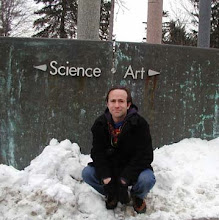The trek included a few solo
discussions of my dissertation work, a session I put together comprised of
other folks doing research in and around comics, and a session I was invited to
participate on the use of comics as a form of research. (I posted a few
reflections on HASTAC’s blog here. And comics
researcher Paul Kuttner, who was in attendance at the comics as research
session, wrote some thoughts about it on his blog here.)
Over the last
few years, having to organize my thoughts in short windows of time in front of
an audience has been extremely instrumental in formulating just what I’m up to
– shaping my work as I’m making it. Despite being well into the dissertation at
this point, this recent week of travel was no less significant in furthering my
thinking. Particularly resonant was a point raised in response to the AERA session
around comics as research by a senior prof in arts-based research about “aesthetics
equaling analysis.” Those three words perfectly articulated what I’m up to – or
at least the approach I try to bring to my work.
Let me explain a
bit. In a broad sense, my work sets out to ask what possibilities for discovery
are we missing when we restrict ourselves to a single mode, specifically the
verbal? In the process of exploring this larger goal of expanding the forms
academic inquiry can take, I need to demonstrate comics are indeed legitimate
for conducting scholarly research. To this end, I see it as imperative to take
an “amphibious” approach – that is not image illustrating text, but fully
integrating visual alongside verbal – making full use of the different
capacities for expression this form possesses that exceed what can be done by
traditional means. And so returning to the salient point raised: in my work aesthetic
concerns and analysis equally inform one another, such that form and meaning are
woven into an inextricable union. It is here, in this joining of form and
meaning, of aesthetics and analysis, that I feel we can create spaces from
which to generate new possibilities for understanding.
So, had I done
this dissertation in text only, it would not only be discernible from what I’m
doing in comics because of the lack of images, but because its entire flow and
shape would be something else altogether. I’ve got ideas I want to explore, but
their ultimate expression is paying heed to the feedback between form and
content and doing my best to hold on and follow where they take me. Making the
work teaches me where I need to go and its visual form is never a secondary pursuit.
I thought I’d
share an old piece, that somewhat speaks to this. A page from “Mind the Gaps,”which is in the book “Narrative Inquiry.” Here, the idea to show a drawing
evolving in time was too dense for the page as I’d had in mind (with 25 different
stages of drawing), so in paring it down, a different means of expressing it
emerged. Prompted by a conversation with my good friend and Game Show NYC
collaborator Andy Malone, I recently thought to animate the original 25
sketches and share them here as a rare bit of animation in this space.
Also, in the
conversation with the super cool people of the Stanford Graphic NarrativeProject, I was asked about how I was planning to undertake the dissertation’s
abstract, bibliography, and acknowledgments. While I’d had fleeting thoughts about
approaching these as the rest of the work, that had been on the back burner.
But this conversation ignited renewed interest in making sure that the form of
these elements was as fully conceived of as the rest of the work. Again –
aesthetics equals analysis and form informs content. All in all, a productive
trip to say the least!
And with that,
back to drawing! Working on the longish, final sequence to Chapter Three. More
soon – Nick





4 comments:
It's good to hear that you're buckling down on text/image interdependence. I was recently reading a work from an anthology which was narrated. I disliked how the dialogue and visuals were weakly coupled and felt the story telling was weak in comparison to the other works. I pointed it out to Becca Hillburn and brought up how some of your pre-dissertation comics would sometimes appear to be tightly coupled but would in stead simply be duplicating the information in both visuals and text. To me, and you've certainly made great progress in this, the sum of the parts should be greater than the whole. Otherwise there is not much point in producing the work in comic form.
Speaking of the animating construction. I saw a few months back a video someone compiled from a 12-page spread of a versioned research paper. There were several hundred commits, maybe even thousands. So you can watch a research paper grow and morph. Sorry I can't find the link.
Joseph,
Thanks for your comment and thinking on this work.
Your comment made me think about which pieces weren't so visual-verbal interwoven! :) Regardless, one hopes that you're always getting better as you do this.
- N
I’m eager to find the valuable information and for me this is the right place to get the good stuff.
read the full info here
Post a Comment